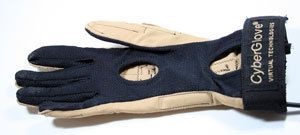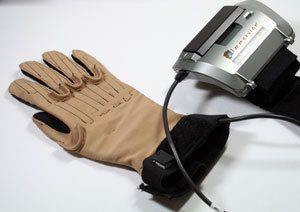CyberGlove key to more realistic movies and games?
Making realistic character animations for games and movies is tough work for graphic artists. Hand gestures are particularly difficult because of the hand's many joints and fingers. Motion tracking devices, such as Immersion Corporation's wireless CyberGlove II, help animators cut production times by allowing them to capture motion, instead of manually moving each digit. Company representatives brought the glove to our offices for a demonstration.

The CyberGlove system consists of a glove that is attached to a wireless Bluetooth transmitter. Inside the glove are strips of metal alloy, called resistive-bend sensors that produce a minute current when a joint is flexed. The readings are fed into a hardware analog/digital converter, which then goes to an animation program or video game. Faisal Yazadi, Immersion's Director of Sales, told TG Daily that the glove has either 18 or 22 sensors, depending on what model is purchased, that capture data at ninety points per second.

Tracking gloves have been in the market for several years and Immersion has been selling an earlier version since 1991. We've seen competing gloves in previous SIGGRAPH show that were bulky and looked uncomfortable. The mesh-fabric in the palm area of the CyberGlove keeps the user comfortable and we wore the glove for about thirty minutes without a problem. You can even write with the glove on, as we found out by signing for a UPS delivery that arrived in the middle of the demonstration.
How does the glove work? A wire goes from the glove to a small transmitter that can be worn on either the forearm or shoulder. The transmitter shoots the readings into an included USB Bluetooth transmitter that is connected to a computer. Yazadi told us that the receiver can support up to two gloves and multiple receivers can be plugged into one computer.
The glove must be calibrated to every hand and this was immediately apparent after we put on the glove. A graphical representation of my hand was displayed in real-time on Yazadi's laptop and some of my fingers and thumb were out of place. Yazadi explained that two calibration methods are available to adjust the gain and offset of each joint. A quick calibration takes readings for a couple hand positions and then guesses the relative position of each joint, while the complete calibration allows every joint to be pushed and pulled. Multiple calibration settings can be saved so profiles can be given to multiple wearers.
All of this hand position data is useless if the animator can't import the motion into a graphical renderer. VirtualHand, optional $2200 software, helps import the readings into Alias' Motion Builder and Maya. The software also includes an open API for developers to hook into other graphical programs.
The wireless CyberGlove II has been sold since last September. Yazadi says that about 1200 gloves, both wired and wireless, has been sold by Immersion. The 18 sensor glove costs $12,295, while the 22 sensor glove is $17,795. "The sensors are made-to-order and we don't sell a lot of them [gloves], that's why they are more expensive," says Yazadi.
Stay on the Cutting Edge
Join the experts who read Tom's Hardware for the inside track on enthusiast PC tech news — and have for over 25 years. We'll send breaking news and in-depth reviews of CPUs, GPUs, AI, maker hardware and more straight to your inbox.
With the push towards more realistic games, the CyberGlove could help game developers make more human-looking hand gestures. Gayle Schaeffer, Immersion's Vice President of Corporate Marketing, told us, "With the release of the Xbox 360 and other game consoles, players will be asking what the next level of realism is. This glove can help developers take games to that level."
Most Popular



